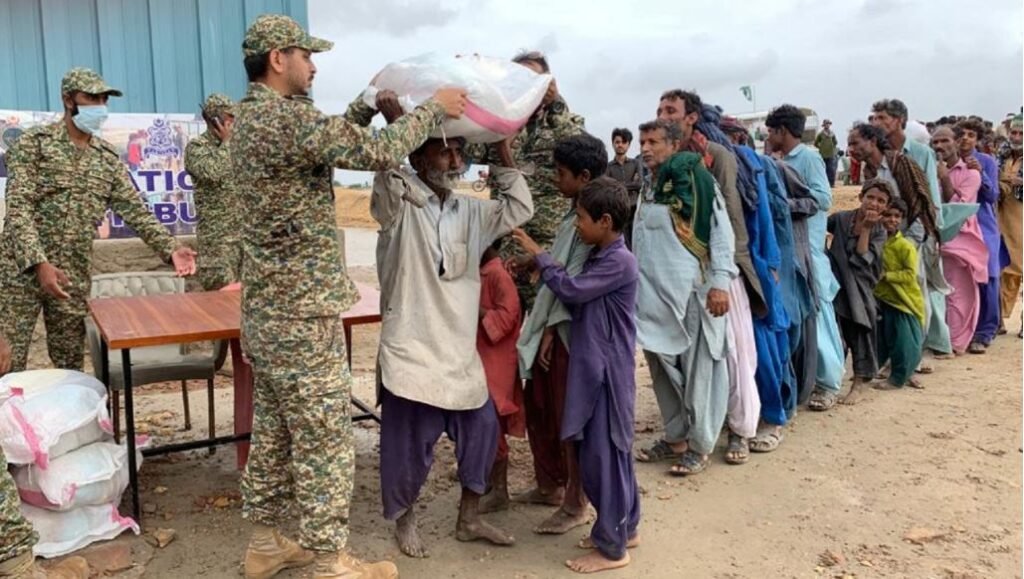
By Anum Khan 25 November 2022
The History of direct as well as quasi-military rule has integrated the military establishment of Pakistan as a major stakeholder in state’s political and administrative system. This has also provided the military establishment with a significant prioritization in the national and foreign policy. The primary rationale for this is the credibility of the institution for its organization and the international recognition the institution has due to its strategic operations for national and regional security. Moreover, Pakistan’s political culture also has the responsibility for lacking effectiveness in defining roles of national institutions, thereby, legalizing the governing capacity of establishment within polity.
Consequently, there is a credible record of civil-military cooperation and coordination in civilian domain as in natural emergency rescue and relief, disaster management, and rehabilitation along with law and order situation. The political governments actually call upon the military for national crisis management services as done during the Covid-19 crisis. This not only adds to the military power, however, increases popularity of the military service in civilian domain as the last resort crisis managers.
In Pakistan, the military role under legal framework derives out of constitutional provisions of the 1973 Constitution of Pakistan. Article 243, 244, and 245 deal with this case. According to Article 243 of the 1973 Constitution of Pakistan, “the Federal Government shall have control and command of the Armed Forces”. Furthermore, Article 245(1) fixes military in civilian administration. It says “the Armed Forces shall, under the directions of the Federal Government, defend Pakistan against external aggression or threat of war, and, subject to law, act in aid of civil power when called upon to do so.”
“HADR – Humanitarian assistance and disaster relief” is the trending area of appreciation for military input into civil domains. The Pakistan military is responsible for disaster management in assistance to the federal government under the legal framework. The National Disaster Management Act 2010 empowers the federal government to call on military service in disaster management during the times of natural calamities. Hence, the constitution pf Pakistan assigns a twofold role to Pakistan First, the defense of the state which is the conventional duty every military is bound to perform; and, second, to assist the civil authorities in the implementation of governance, however, subject to a legal call by the civilian administration for a specific purpose.
Likewise, during the 2005 earthquake, 50,000 troops were moved for emergency relief services. Five forward military posts were established for coordinating the relief efforts and carrying out distribution of food and other necessary goods. Federal Relief Commission (FRC), headed by a major general supervised relief services including food, medical care, shelter, and more. Military medical teams were tasked to provide medical care to earthquake affectees.
Similarly, during the 2010 floods, military’s comprehensive response included about 50,000 troops deployment for evacuation operations and rescue services in the affected areas under the directions of General Headquarters –GHQ, and the Corps Headquarters. Major army corps, officers from Army Aviation Command and the Special Support Group were part of the operation. Joint Aviation Coordination Cell (JACC) in coordination with National Disaster Management Authority and Pakistan prioritized ‘fixed wing and rotary wing flying’ for carrying out relief operations. Eight-hundred and fifty-thousand evacuations were made via six-hundred boats, C-130 planes, and helicopters relief. According to the National Disaster Management Authority reports, military diverted 25% of its budget to the flood response. Pakistan Air Force flew almost 550 helicopters, 1300 C-130s and 20 reconnaissance flights into affected areas, rescuing approximately 23 thousand people. Meanwhile, Navy conducted operation based on 200 boats, six helicopters and other specialised equipment.
An analysis of Pakistan military’s self-procured non-traditional security function at times of the 2005 earthquake and the 2010 floods infer two observations that are quite significant: First, Humanitarian assistance and disaster relief during the national security crisis recognizes military forces intervention as humanitarian response. Second, military interventions in the form of humanitarian response makes a rapid, timely as well as efficient disaster management strategy that have been proven during the floods and earthquake crisis situations in Pakistan. Therefore, besides having recognized as the most organized and expert instrument of national defence and security, Pakistan military also holds credibility for its services in non-traditional security issues within the civilian domain of administration.
*The author is an independent researcher based in Islamabad.
